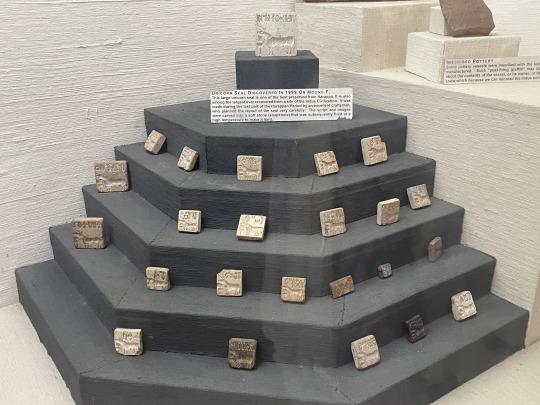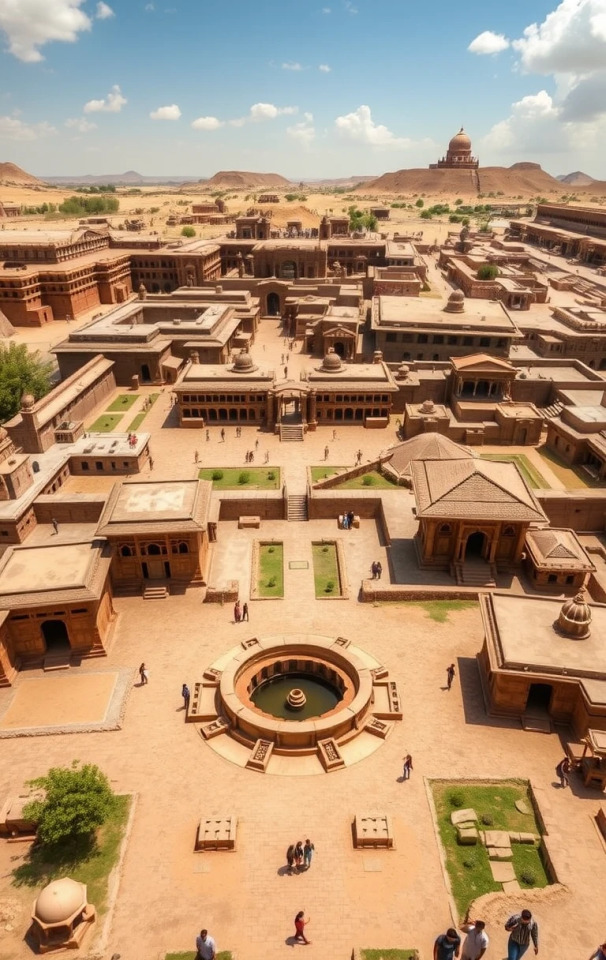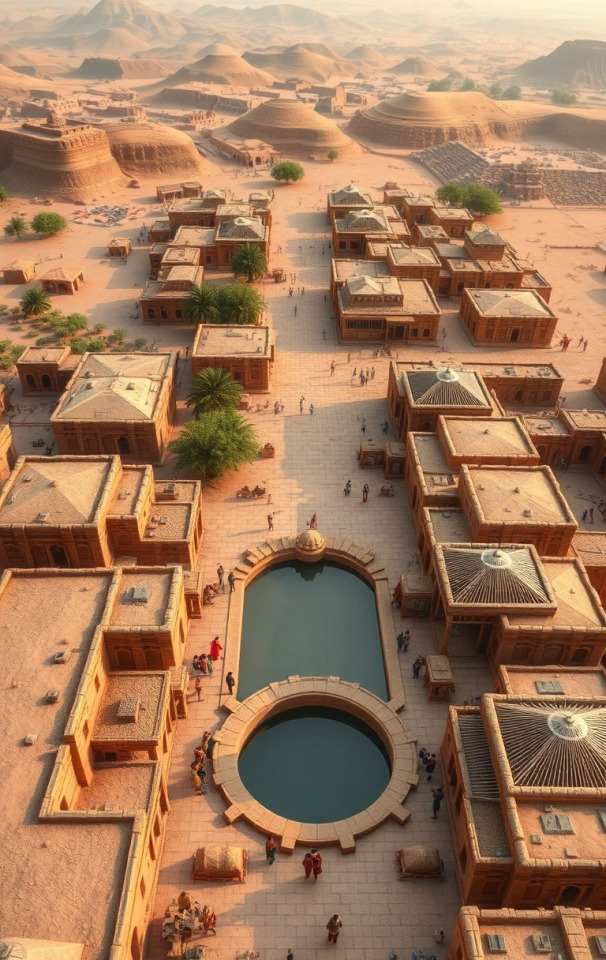#Harappa
Explore tagged Tumblr posts
Photo

The Indus Valley Civilization was a cultural and political entity which flourished in the northern region of the Indian subcontinent between c. 7000 - c. 600 BCE. Its modern name derives from its location in the valley of the Indus River, but it is also commonly referred to as the Indus-Sarasvati Civilization and the Harrapan Civilization. These latter designations come from the Sarasvati River mentioned in Vedic sources, which flowed adjacent to the Indus River, and the ancient city of Harappa in the region, the first one found in the modern era. None of these names derive from any ancient texts because, although scholars generally believe the people of this civilization developed a writing system (known as Indus Script or Harappan Script) it has not yet been deciphered. All three designations are modern constructs, and nothing is definitively known of the origin, development, decline, and fall of the civilization. Even so, modern archaeology has established a probable chronology and periodization: Pre-Harappan – c. 7000 - c. 5500 BCE Early Harappan – c. 5500 - 2800 BCE Mature Harappan – c. 2800 - c. 1900 BCE Late Harappan – c. 1900 - c. 1500 BCE Post Harappan – c. 1500 - c. 600 BCE The Indus Valley Civilization is now often compared with the far more famous cultures of Egypt and Mesopotamia, but this is a fairly recent development. The discovery of Harappa in 1829 CE was the first indication that any such civilization existed in India, and by that time, Egyptian hieroglyphics had been deciphered, Egyptian and Mesopotamian sites excavated, and cuneiform would soon be translated by the scholar George Smith (l. 1840-1876 CE). Archaeological excavations of the Indus Valley Civilization, therefore, had a significantly late start comparatively, and it is now thought that many of the accomplishments and “firsts” attributed to Egypt and Mesopotamia may actually belong to the people of the Indus Valley Civilization. The two best-known excavated cities of this culture are Harappa and Mohenjo-daro (located in modern-day Pakistan), both of which are thought to have once had populations of between 40,000-50,000 people, which is stunning when one realizes that most ancient cities had on average 10,000 people living in them. The total population of the civilization is thought to have been upward of 5 million, and its territory stretched over 900 miles (1,500 km) along the banks of the Indus River and then in all directions outward. Indus Valley Civilization sites have been found near the border of Nepal, in Afghanistan, on the coasts of India, and around Delhi, to name only a few locations. Between c. 1900 - c. 1500 BCE, the civilization began to decline for unknown reasons. In the early 20th century CE, this was thought to have been caused by an invasion of light-skinned peoples from the north known as Aryans who conquered a dark-skinned people defined by Western scholars as Dravidians. This claim, known as the Aryan Invasion Theory, has been discredited. The Aryans – whose ethnicity is associated with the Iranian Persians – are now believed to have migrated to the region peacefully and blended their culture with that of the indigenous people while the term Dravidian is understood now to refer to anyone, of any ethnicity, who speaks one of the Dravidian languages. Why the Indus Valley Civilization declined and fell is unknown, but scholars believe it may have had to do with climate change, the drying up of the Sarasvati River, an alteration in the path of the monsoon which watered crops, overpopulation of the cities, a decline in trade with Egypt and Mesopotamia, or a combination of any of the above. In the present day, excavations continue at many of the sites found thus far and some future find may provide more information on the history and decline of the culture.
146 notes
·
View notes
Note
now YOU 🫵 give us the fun facts about the indus valley civilization drainage system 🪠
YES!
i was gonna make several essay posts about the indus valley civilization but the drains can start here:
context: this civilization (also known as the harappan civilization) was roughly from the 33rd century bce to the 13th century bce. for reference, alexander the great was born about 3,000 years after the first indus valley settlements were established
i will talk about other absolutely incredible features of this civilization in subsequent posts, but for now: the drains.
anyone who has more than passing knowledge of the indus valley civilization will almost definitely be obsessed with harappan drains. we cannot shut up about them. hold up here’s a picture:

(source)
harappan drains were typically made of gypsum or limestone, and they were lined with burnt bricks which means they were better (or at least more durably) built than most houses, which were mud-bricked. these bricks were of the same ratio (l:b:h :: 4:2:1) throughout the settlement, which covered a whole lot of ground!! as far as we can tell, the civilization extended to about 1.2 million square miles. also, they were COVERED. BEAUTIFULLY. LOOK AT THE ARCH ON THAT THING. THEY HAD MANHOLE COVERS.
anyway. one thing about the indus valley civilization was its incredibly meticulous town planning, which involved first laying down streets with drains and then building houses beside them. these drain streets were at 90 degree angles and were spaced out very evenly, and every house was connected to a drain through smaller drains in bathrooms, which they had!! people didn’t usually have those, but these guys did!! also, all street drains led to a main underground drain that took everything out of the city. man.
also, this incredibly sophisticated drainage system wasn’t relegated to “elite” parts of the settlement (not that we’re sure they had any in the first place, but that’s a story for another time). as far as we can tell, they were built for the convenience (and sanitary use) of ordinary people. these people prioritized healthcare and sanitation. in 33,000 bce.
also, as far as modern archaeology has discerned, harappa was the first civilization to have had a drainage system at all
i’m realising now that this may not sound very impressive, so here are some contemporary systems for comparison: in the mesopotamian civilization, drains were built with the primary purpose of fending off floods, and they formed a very complicated network that often overlapped and was, uh. confusing as shit. in densely populated cities like ur, refuse was often just swept into the street. ancient egypt had a very well-developed system of canals for irrigation, and there was a lovely system of water engineering, but drainage were usually done through sluice gates (they did have bathrooms too, though! they specifically had toilets built over a shaft that lead to a sewer system that flowed into the nile). keep in mind that the drainage systems of both these civilizations did develop far later in the history of the civilization than they did at harappa
okay that’s it for that rant thank you for listening!! if i’m wrong about anything please please correct me
31 notes
·
View notes
Text
I'm just gonna say it.
It is okay if IVC had an entirely separate religion, or lack, thereof. Please do not view this civilization with a predisposition or from the lens of an already-existing religion. Be more open-minded.
#indus valley#indian history#harappan civilization#mohenjo daro#harappa#ancient civilizations#ancient city#ancient history#ancient culture#ancient#desiblr#desi tumblr#desi tag#desiposting#desi side of tumblr
57 notes
·
View notes
Text

#book cover#cover design#Harappan#Harappa#civilization#Harappan civilization#language#linguistcis#Akkadian#Sanskrit#anthropology#history#Malati Shendge#Indology#Indus Valley#culture
8 notes
·
View notes
Text
The Rig Veda and the origins of the first cities of the Indus-Sarasvati valley.
At the intersection of legend, mythology and archaeology lies an ancient text: the Rig Veda, one of humanity’s oldest sacred texts. But what does it really tell us about the origins of the first cities of the Indus Valley and Sarasvati, this mysterious civilization of the 7 rivers, whose first cities emerged around 3500 BCE? The “official” version – or at least the one that remains widely…
#Aryan Invasion#harappa#Indus valley#Mohenjo-daro#rig veda#Sanskrit#sarasvati#Seven Rivers Civilization
2 notes
·
View notes
Text

A street at the ancient city of Harappa in Pakistan. 2500-2000 BCE, Indus Valley Civilisation.
6 notes
·
View notes
Text

#Indus Valley Civilization#unicorn seal#ox seal#Harappa Museum#Harappa#Sahiwal#Punjab#Pakistan#stamps
2 notes
·
View notes
Text

Long before Rome or Greece, the Indus Valley Civilization thrived with advanced urban planning, drainage systems, and trade networks. Mohenjo-Daro and Harappa remain symbols of an advanced yet mysterious past. 🏺✨

#AncientIndia#IndusValley#HistoryLovers#LostCivilizations#Archaeology#MohenjoDaro#Harappa#IndianHistory#AncientMysteries#WorldHistory
0 notes
Photo

Origine des Religions en Inde
Les pratiques religieuses des premiers Indo-Aryens, constituant la religion védique (1500-500 av. J.-C.), furent écrites puis rédigées en sanskrit archaïque dans les Samhitas, ensemble de quatre recueils canoniques d'hymnes ou de mantras, appelé le Veda.
Lire la suite...
#Histoire#Vishnu#Vardhamana#Upanishads#LesVédas#SiddharthaGautama#Shiva#Religion#Jaïnisme#Inde#Hindouisme#Ganesha#LeBouddhisme#BhagavadGita#Avesta#Aryen#Harappa
0 notes
Photo

Ancient Secrets
Imagine an ancient civilization that rivaled Egypt and Mesopotamia in sophistication but remains a mystery to this day. The Indus Valley Civilization was a fascinating culture that thrived between 7000 and 600 BCE in the Indian subcontinent. Its cities like Harappa and Mohenjo-Daro hosted large populations, suggesting a highly developed urban society. Yet, despite its impressive accomplishments, the civilization's writing system remains undeciphered, leaving many secrets untold.
Introduction
The Indus Valley Civilization, spanning over 900 miles, was a cultural and political powerhouse. Its cities were significantly larger than most ancient urban centers, with populations reaching between 40,000 to 50,000 people.
Key Facts
Periodization:
Pre-Harappan (c. 7000 - 5500 BCE)
Early Harappan (c. 5500 - 2800 BCE)
Mature Harappan (c. 2800 - 1900 BCE)
Late Harappan (c. 1900 - 1500 BCE)
Post Harappan (c. 1500 - 600 BCE)
Located in the Indian subcontinent, with sites found as far as Afghanistan and Nepal.
Cities: Harappa and Mohenjo-Daro were major urban centers.
Population: Estimated 5 million people.
The Indus Valley Script remains undeciphered.
Historical Context
The Indus Valley Civilization was discovered relatively late compared to others like Egypt and Mesopotamia. This delayed discovery has led to the realization that some historical "firsts" attributed to these civilizations might actually belong to the Indus Valley people.
Historical Significance
The civilization's sophisticated urban planning and large population sizes highlight its advanced societal structure. The civilization's achievements suggest that it may have been a pioneer in various aspects of ancient culture.
Why You Should Know About It Today
Understanding the Indus Valley Civilization provides insights into the early development of human societies and challenges common historical narratives about the origins of civilization. Its mysterious script continues to fascinate scholars and the public alike, promising new discoveries in the future.
59 notes
·
View notes
Text
okay quick question to get a general idea
also, it’d help if you could mention which of the two names for the civilization you’ve heard more of
27 notes
·
View notes
Text
youtube
It’s very easy to revise and retain History through solving MCQs. In this series we will try to solve basic questions to revise entire syllabus of History.
0 notes
Text
To what extent has the urban planning and culture in the Indus Valley Civilization provided inputs to the present day urbanization? Discuss.

0 notes
Text
Le dixième Mandala du Rig Veda : réflexions sur la fin de la civilisation des 7 rivières
Le Rig Veda est un recueil ancien de chants sacrés. Il nous parle d’un monde révolu, celui de la civilisation des 7 rivières, une société sans armée, sans esclavage, avec des villes bien organisées, des maisons confortables, des canalisations et un profond respect pour la nature. Le dixième Mandala, le dernier livre du Rig Veda, semble avoir été ajouté à la fin de cette grande époque. Pourquoi…
0 notes
Text



the Harappan hits: the “Pashupati” seal, Dancing-Girl and the “Priest-King” figure


Harappan clay figurine. This one depicts a mother breastfeeding her little child :)
196 notes
·
View notes
Text

3 notes
·
View notes